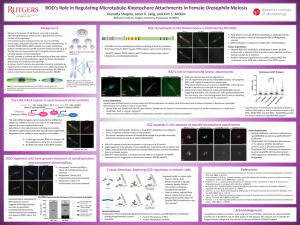Shapiro, Joanatta: “ROD’s Role in Regulating Microtubule-Kinetochore Attachments in Female Drosophila Meiosis
Title: “ROD’s Role in Regulating Microtubule-Kinetochore Attachments in Female Drosophila Meiosis
Name: Joanatta Shapiro
Major: Molecular Biology and Biochemistry
School affiliation: School of Arts and Sciences
Programs: Honors College with Johnson & Johnson Women in STEM2D Life Sciences Summer Undergraduate Research Fellowship (HCW-SURF)
Other contributors: Janet Jang and Kim McKim
Abstract: Meiosis is a complicated yet highly conserved process of cell division occurring in all sexually-reproducing eukaryotes in which the resulting gametes have half the number of chromosomes. Errors in this process (chromosome nondisjunction) can result in infertility, miscarriages, and genetic disorders. Consequently, understanding the proteins involved in meiosis will help elucidate possible causes of these disorders. One poorly understood protein in meiosis, ROD, is known to be partially responsible for the spindle assembly checkpoint (SAC) in mitosis. The SAC ensures that chromosomes do not segregate until the spindle is correctly attached. ROD localizes to the kinetochores, the region of the chromosomes where spindle fibers attach, and usually streams off during meiosis I, possibly after spindle-kinetochore attachments have formed or bi-orientation occurs. Additionally, flies that do not express ROD are sterile and have chromosome orientation defects. Thus, ROD is hypothesized to be imperative for correct spindle attachment and chromosome orientation. To determine the function of ROD in meiosis, the spindle structure, spindle-kinetochore attachments, and chromosome orientation were observed in Drosophila oocytes where the Rod mRNA cannot be translated. Furthermore, the effects of knocking down other kinetochore proteins on ROD were observed to determine possible protein interactions. Determining the function of ROD in meiosis and the mechanisms by which it works will provide valuable insight into how pairs of homologous chromosomes segregate correctly and reasons behind nondisjunction.
